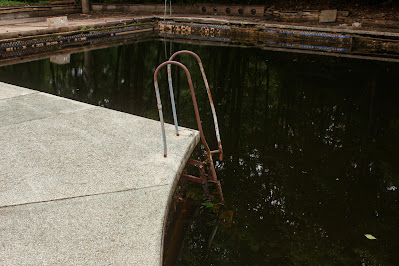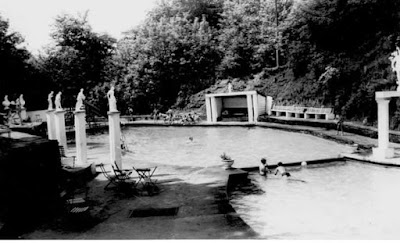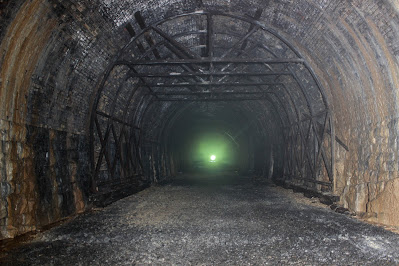It's been a while since I blogged about a Lido, the previous post being back in 2018 and local to me. It was rather generic, as far as pools go. This one is completely different. It's a bit further afield, but somewhat unique, with pillars and statues and a bit of an ancient Grecian or Roman vibe, but surrounded by woodland. As soon as I saw images online, I knew I would have to see it in person. I like quirkiness. I probably wouldn't travel this far for an abandoned cottage, but anything unique and unconventional is sure to get my attention. It's not every day one finds something like this in the middle of the woods.
But what's the story of this place? Well, it's difficult to pinpoint when the pool was actually constructed, but it exists on the grounds of an old mansion, so presumably it was once the private pool of one of the former occupants. It eventually did open to the public, but the remains of pillars and statues hint at the former refinery.
Many of the pillars and statues have been destroyed, but some are still lying around, with moss growing on them.
The eagles still stand, one on each pillar in the corner of the pools deep end, facing each other to give it all a bit of symmetry.
So, we can look at a few of the mansions former occupants and perhaps guess which one of them wanted to swim in an awesome pool in his downtime. I think the mansion itself is now apartments or a private dwelling. Either way, it's occupied and not connected to the pool anymore, so I won't be venturing up to it.
Prior to the current mansion, there was another, which was built for a rich chap called Joseph to retire in. Joseph was a bit of a local legend. He was born in 1665 to a very poor family, but he used to carry around a basket of stuff that he would sell. I'm not even sure what kind of stuff. Could have been jewelry. Could have been a cursed monkey paw. Records are vague. But he used the money to buy a donkey, and then when he was 21 he set off for London to sell yarn. He ended up doing so well that other cotton merchants had him dragged in front of a parliamentary committee, complaining that he was monopolising the import of cotton. That never went anywhere though, and he just went from strength to strength.
The cool thing about Joseph isn't that he made himself rich from rock bottom, but that his experience at rock bottom made him a good rich person. Unlike today's rich people who just diddle kids, Joseph actually adopted them and paid for their education, and even had a school built. His own biological children, twelve in total, never survived to adulthood, so perhaps he also had a void he wanted to fill. But his generosity was quite well known, and there was a monument made for him after he died in 1786.
The monument ended up removed, but his nephew Jack would eventually hunt it down and restore it in the local church, where it sits to this day.
Funnily enough, Joseph was called upon to help restore a big stone cross after it was vandalised. Some local kids had broke off a chunk of it, and attempted to take it to the top of a hill. They managed to get pretty far for kids carrying a half metric ton of holy stone uphill in the dead of night, but ultimately they decided to ditch it in a field. I'm not sure why Joseph was called upon to restore it, but he refused, and the chunk of rock still sits there, where it is passed by dog walkers every single day. Ironically it outlived the monument it was stolen from.
I love these stone stairs down into the pool, purely because of how ancient they look.
Also on the side of the pool are numeric indicators that tell how deep the pool is, presumably in feet.
When Joseph died, his mansion... well, his nephew Jack got it, but Jack was born in 1790, or 1791 depending on varying sources. That's some time after Joseph died, which means that even though he's mentioned as the next in line, he can't possibly have been. Unless Joseph was clairvoyant, he wouldn't leave his mansion to a child who hadn't even been conceived.
Maybe he was clairvoyant. Who knows?
Jack did a lot of horse racing, and once sailed a load of emigrants to New Zealand. But most relevantly he had the mansion rebuilt in 1811, creating the fourteen-bedroom bonanza that exists today. It's entirely possible that he had the pool built when he had the house rebuilt. It's the perfect opportunity for it, after all.
My favourite thing about Jack was his petty streak. He purchased a pub, had it converted into a vicarage, and let every succession of local vicar live there rent free, until in 1865 when the village appointed a vicar that he didn't like, at which point he had the building turned back into a pub.
That's the sort of pettiness I admire. Fuck the vicar, give people a place to drink.
Towards the other end of the pool is the shallow end, and thanks to the internet I've managed to find vintage shots that show this angle, roughly, from the 1960s.
(Picture not mine, obviously)
As you can see, there were once more pillars and on top of them all were little statues. Now barely any of these remain. Perhaps they were stolen or smashed. Perhaps they're in the pool.
Of the pillar statues, one remains.
She's not in the best of shape, having lost her head and her hands. But of all the figures perched on the pillars, she's the only survivor.
I'm
not sure what happened to Jack, but in 1869 the mansion was purchased
by the local mayor, Francis, who had become filthy rich by buying a mill with some inheritance money.
It's entirely possible that Mayor Francis is the one who had the pool built. In the UK, recreational swimming really took off in 1875, when people like Matthew Webb swam across the English Channel. It would only become increasingly more and more popular as the years progressed, but the mayors occupancy does coincide with the era when it was started to take off.
He passed away in 1884, ending the
mansions era of private ownership.
While it is commonly said that the pool was then used by a private country club, I can't find much solid info on that. But in 1901 it was obtained by the Co-Operative Holiday Association, an organisation established in 1893 to provide free or affordable holidays to poor or handicapped people.
This was the brainchild of Thomas Arthur Leonard, who pioneered "rational holidays" to combat commercial exploitation. He sounds like a great guy. As someone who does enjoy traveling, I've learned that it can be done for a lot cheaper than we're led to believe. Thomas Arthur Leonard was also instrumental in setting up the Youth Hostel Association in 1931, who owned that big castle-mansion that I recently blogged about. If it wasn't for Thomas Arthur Leonard, George Orwell may have had a happier time and wouldn't have had to sell his scarf.
Thomas Arthur Leonard was also a big fan of Germany, before all that stuff with the Nazis kicked off. He was big on setting up places in Germany for people to stay on holiday. But likewise, he turned this mansion and the pool into accommodation for German holiday goers. There's a picture that shows a load of them here, although no recognisable background features are in the image.
(Picture not mine, obviously)
But it's safe to say that everyone photographed here has probably swam in this pool.
The Co-Operative Holiday Association allegedly had the mansion and the pool right up into the 1930s, which clashes a bit with claims that a country club had it in the 1920s. And then in 1938, the pool was officially opened to the public.
Across the pool is a statue standing next to a couple of pillars. But what's really interesting is the statue doesn't appear in the retro shots of the place. Someone has moved it there from elsewhere around the pool.
The pool became incredibly popular with young people throughout the 1940s, 1950s and 1960s. There are numerous photos and video footage that depict children playing in the crowded pool. Apparently there was a bus service that dropped children off right outside the main entrance, so they'd just swing by after school. Because it was actually fed by a mountain stream, it was incredibly cold in the summer months, which added to its popularity.
According to folks reminiscing about the place, access cost a shilling for children and half a crown for adults. According to the internet, a shilling is the old-money equivalent of 5p, and a crown is the equivalent of about 25p. But that's not taking inflation into consideration. 5p could buy you a lot more several decades ago. Even back when I was homeless, 5p was a third of the cost of a Freddo bar, making it my go-to hobo snack. Those were the days.
But anyway, in 1947 there was apparently one hell of a storm, and a huge quantity of water cascaded down from the moors above, flooded a load of houses, and made a mess of the pool. In the morning the pool was full of soil and trees, and dead or dying fish. Turns out people don't like swimming with dead or dying fish. The pool was forced to shut down temporarily.
But it was such a local treasure that everyone from the surrounding area came together to rescue it. Some say it was never the same again though, although nobody has elaborated on that. The fact is, it was still open and popular in the 1960s, so it can't have been that bad. I've found another old shot, that is almost the same angle as this one.
It looks so amazing. And there's a little seating area across the pool too that is no longer there. Notice how that statue I mentioned is also missing.
I'm quite fond of these steps at the end of the pool.
I'm also quite fond of this retro sign saying "Bathers only." No non-swimmers could come down the steps to the swimming area.
I'm not sure when or why the pool closed to the public, but the sad truth about lidos is they really peaked in the inter-war era of the 20th Century and then had a steady decline as tastes changed and attendance fell. In the end, outdoor swimming pools just weren't profitable. Many lidos became derelict, like this one. Many more were just demolished. It's a shame because I think they're worth preserving. In fact, I would love to see outdoor swimming make a comeback. Wild swimming is certainly getting popular, so an outdoor pool comeback could work.
This pool fell into the stuff of local legend, and as it became more and more overgrown, it only seemed to appear more magical, like some sort of forgotten lost kingdom. Apparently numerous photoshoots and music videos have been had here, but I haven't found any of them. In the 1990s, someone did try to buy it and convert the changing area into a place to live. They apparently started clearing out much of the jungle that had taken over the pool area, but then the council refused their planning permission, so they gave up and left.
Here's a closeup of the statue that doesn't appear in the older vintage shots. Someone moved it here to the edge of the pool. That's probably how it lost its arms.
In the background, stairs lead up to the buildings that used to be the changing area, and eventually up to the mansion itself, which is currently a set of apartments. But up on that dividing wall is a fresh coat of paint and a sign warning of dogs, so I didn't want to venture too far up there. It's the pool that I came here to see.
And that brings me to the end of this blog. Next time I'll be in an abandoned theatre. It's not the best abandoned theatre on my horizon or even in my past, but it's still cool. And then after that, I'm on a boat! But again, not the best boat I've got on my horizon either. Followers on Instagram will know what the best boat is. So speaking of Instagram, follow me on there. Follow me on Vero and Reddit too. They're alright. And if you're the kind of person who enjoys wasting their life as their brains turn to mush, then you're probably on Facebook and Twitter, so follow me on those too.
Thanks for reading!
































































